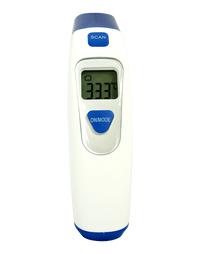Different types of thermometers and their uses

Healthcare professionals have long been aware that human body temperature is one of the four vital signs of human health. Optimal body temperature for healthy humans is 36.3¼ to 37.3¼ and any variation in temperature may be indicative of ill health. Consequently, the thermometer has been an integral tool in saving the lives of patients by alerting physicians to the presence of infection.
Until recently, this humble device has largely been taken for granted as a somewhat ordinary piece of nursing equipment by the general public. However, the thermometer has taken centre-stage in our lives lately with everyone from airport officials to gym attendants wielding handheld thermometers as part of the effort to stop the spread of COVID-19. As a result, its importance in monitoring human health has become increasingly evident.
The product of centuries of scientific research, the thermometer has been developed and modified over the years to meet the requirements of its many different uses. In this article, we take a closer look at the different types of thermometer commonly used by nurses and health care workers.
We've come a long way from the traditional glass and mercury thermometers which were placed under the tongue, in the armpit or into the rectum of the patient. The length of a column of silver liquid would be used to determine your temperature. These were abandoned in favour of digital thermometers due to the risk of injury and mercury poisoning posed by broken thermometers.
We've all become familiar with infrared (forehead) thermometers in recent months due to their quick, easy, contactless measurement abilities. Simply point the thermometer at the patient's forehead and in very little time a reasonably accurate temperature reading is produced. This ease-of-use has led to the widespread application of these thermometers in a variety of settings.
Digital thermometers are placed in the same positions as their mercury predecessors. Although the under arm is usually best for children under 5 years old. These thermometers provide the fastest and most accurate readings. A digital display shows the patient's temperature. They are available in pharmacies and are used in both homes and hospitals.
Ear thermometers use infrared technology to take the patient's temperature once inserted into the ear. Incorrect placement in the ear and the presence of ear wax may have an effect on the accuracy of the reading. Also called tympanic thermometers, they take the temperature within one second of placement. This makes them ideal for use on babies and young children or patients who are unable to remain still for long enough to use a digital thermometer.
Strip-type thermometers consist of thin plastic strips that are placed on the forehead. They require the patient to remain very still during reading and are not very accurate. However, due to their light weight and small size they may be useful in situations where proper medical equipment is not readily available, such as while camping or bushwalking.
eNurse carries a full range of thermometers for health care professionals, find your ideal thermometer here:
https://www.enurse.com.au/product-category/equipment/diagnostic-equipment/thermometers/




